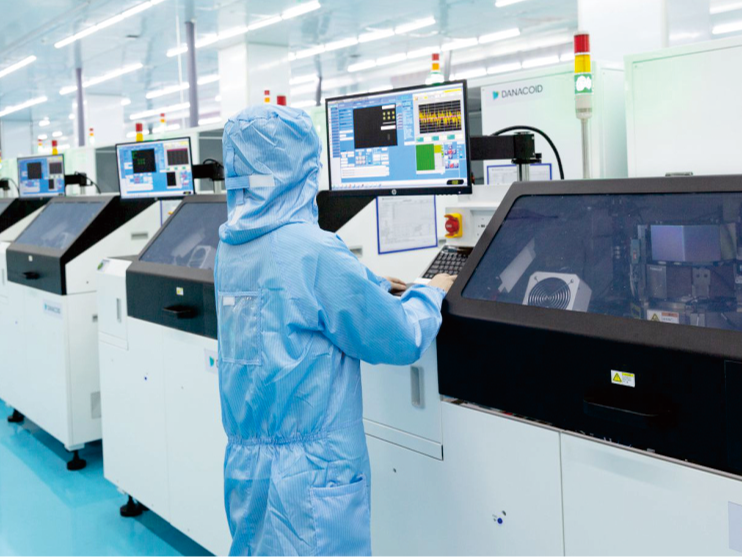An audio processing system transforms sound into a format you can analyze, enhance, or reproduce. It plays a vital role in applications like music production, speech recognition, and live sound reinforcement. The system relies on four main components: Audio Input Devices, Audio Preprocessing, Audio Processing Units, and Output Devices. Each part serves a unique purpose, but they must work together seamlessly. This collaboration ensures accurate sound capture, effective processing, and high-quality output. Understanding these components helps you appreciate how audio systems deliver clear and immersive sound experiences.
Audio Input Devices
Audio input devices serve as the starting point of any audio processing system. These devices capture sound from the environment or other sources and convert it into a format that can be processed further. Understanding the role of these devices helps you appreciate how sound enters the system and begins its journey through the main components.
Microphones
Microphones are among the most common audio input devices. They capture sound waves and transform them into electrical signals, making them essential for recording, broadcasting, and live performances.
Types of microphones (e.g., dynamic, condenser, ribbon)
Microphones come in various types, each designed for specific applications. Dynamic microphones are durable and handle high sound pressure levels, making them ideal for live performances. Condenser microphones are more sensitive and capture detailed audio, which makes them perfect for studio recordings. Ribbon microphones, known for their warm and natural sound, are often used in professional settings to record vocals or acoustic instruments.
How microphones convert sound waves into electrical signals
Microphones work by converting sound waves into electrical signals. When sound waves hit the microphone's diaphragm, it vibrates. These vibrations create changes in an electrical circuit, producing a signal that represents the original sound. This process ensures that the sound is accurately captured for further processing.
Other Input Devices
While microphones are widely used, other input devices also play a crucial role in audio systems. These devices allow you to introduce different types of audio signals into the system.
Line-in inputs (e.g., instruments, mixers)
Line-in inputs connect external audio sources directly to the system. Instruments like electric guitars or keyboards use line-in connections to send their signals for processing. Mixers, which combine multiple audio signals, also rely on line-in inputs to feed their output into the system. These connections ensure that diverse audio sources can integrate seamlessly.
Digital audio sources (e.g., pre-recorded files, streaming)
Digital audio sources provide pre-recorded or live-streamed audio directly to the system. Files stored on computers or mobile devices, as well as streaming platforms, deliver audio in digital formats. These sources bypass the need for analog-to-digital conversion, ensuring high-quality input for further processing.
Audio Preprocessing
Audio preprocessing prepares raw audio signals for further analysis or processing. This step ensures that the audio data is clean, optimized, and ready for use in various applications. By focusing on signal conditioning, sampling, quantization, and feature extraction, you can enhance the quality and usability of audio signals.
Signal Conditioning
Signal conditioning improves the quality of audio signals by addressing issues like noise and imbalance. This step ensures that the input signal is clear and well-suited for subsequent processing.
Noise reduction and filtering
Noise reduction removes unwanted sounds from audio signals. Background noise, electrical interference, or environmental disturbances can degrade audio quality. Filters, such as low-pass, high-pass, or band-pass filters, help isolate the desired frequencies while eliminating irrelevant ones. You can use these techniques to ensure that the audio signal remains clean and focused.
Equalization and gain adjustment
Equalization adjusts the balance of different frequency components in an audio signal. You can emphasize or reduce specific frequencies to achieve a desired tonal quality. Gain adjustment ensures that the signal's amplitude stays within an optimal range. This step prevents distortion and ensures consistent volume levels across the audio.
Sampling and Quantization
Sampling and quantization convert analog audio signals into digital formats. This process allows you to store, analyze, and manipulate audio using digital tools.
Sampling rate and bit depth
The sampling rate determines how often the audio signal is measured per second. A higher sampling rate captures more detail, resulting in better audio quality. Bit depth defines the resolution of each sample. Greater bit depth provides a wider dynamic range, which preserves subtle details in the audio. Choosing the right sampling rate and bit depth ensures accurate digital representation of the original sound.
Importance of anti-aliasing filters
Anti-aliasing filters prevent distortion during the sampling process. When the sampling rate is too low, high-frequency components can create artifacts known as aliasing. These filters remove frequencies above the Nyquist limit, ensuring that the sampled audio remains true to the original signal. Using anti-aliasing filters helps maintain the integrity of the audio during digitization.
Feature Extraction
Feature extraction identifies key characteristics of audio signals. These features are essential for tasks like speech recognition, music analysis, and machine learning applications.
Spectral analysis (e.g., FFT, spectrograms)
Spectral analysis breaks down audio signals into their frequency components. Techniques like Fast Fourier Transform (FFT) and spectrograms visualize how frequencies change over time. These tools help you understand the structure of the audio and identify patterns or anomalies.
Key features for machine learning models (e.g., MFCCs)
Machine learning models rely on specific audio features for training and inference. Mel-Frequency Cepstral Coefficients (MFCCs) are widely used in speech and audio recognition tasks. These features capture the perceptual aspects of sound, making them ideal for applications like voice assistants or music classification. Extracting the right features ensures that your models perform effectively.
Audio Processing Units
Audio processing units handle the core tasks of transforming and enhancing audio signals. These units execute complex operations that shape the sound you hear. They include hardware components, artificial intelligence models, and software tools. Each plays a critical role in ensuring high-quality audio output.
Digital Signal Processors (DSPs)
Digital Signal Processors (DSPs) are specialized hardware designed for real-time audio processing. They perform calculations at high speeds, making them essential for applications requiring immediate results.
Role of DSPs in real-time audio processing
DSPs process audio signals with precision and speed. They handle tasks like filtering, equalization, and dynamic range control. In live sound systems, DSPs ensure that audio adjustments occur instantly, preventing delays. You can rely on DSPs to maintain audio quality during live performances or broadcasts.
Common DSP algorithms (e.g., compression, reverb)
DSPs use algorithms to modify audio signals. Compression reduces the dynamic range of audio, balancing loud and soft sounds. Reverb adds depth and space to audio, simulating environments like concert halls or small rooms. These algorithms enhance the listening experience by shaping the sound to meet specific needs.
AI and Machine Learning Models
Artificial intelligence (AI) and machine learning models have revolutionized audio processing. They enable systems to analyze and adapt to audio data in ways that were previously impossible.
Applications of AI in audio processing (e.g., speech recognition, noise cancellation)
AI powers applications like speech recognition and noise cancellation. Speech recognition systems convert spoken words into text, enabling voice assistants and transcription services. Noise cancellation removes unwanted background sounds, improving clarity in calls or recordings. These technologies rely on AI to deliver accurate and efficient results.
Training and inference in audio models
Machine learning models require training to perform effectively. During training, the model learns patterns from large datasets of audio. Once trained, the model uses inference to process new audio data. For example, a speech recognition model identifies spoken words based on its training. Understanding this process helps you appreciate how AI enhances audio systems.
Software-Based Processing
Software-based processing provides flexibility and accessibility in audio processing. It allows you to use digital tools to manipulate and enhance audio signals.
DAWs (Digital Audio Workstations) and plugins
Digital Audio Workstations (DAWs) are software platforms for recording, editing, and mixing audio. They offer tools for tasks like multitrack editing and sound design. Plugins expand the capabilities of DAWs by adding effects like equalization or reverb. You can use DAWs and plugins to create professional-quality audio projects.
Cloud-based audio processing
Cloud-based audio processing enables you to work on audio projects without relying on local hardware. These services process audio data on remote servers, offering scalability and convenience. For instance, you can use cloud platforms to edit audio files or apply advanced effects. This approach simplifies collaboration and reduces the need for powerful local systems.
Output Devices
Output devices play a crucial role in delivering the final audio to the listener. These devices convert processed audio signals into sound or other usable formats. Understanding their functionality helps you choose the right tools for your audio processing needs.
Speakers
Speakers are essential output devices that transform electrical signals into audible sound. They are widely used in various settings, from professional studios to Home entertainment systems.
Types of speakers (e.g., studio monitors, consumer-grade)
Speakers come in different types, each designed for specific purposes. Studio monitors provide accurate sound reproduction, making them ideal for mixing and mastering audio. They ensure you hear every detail without coloration. Consumer-grade speakers, on the other hand, prioritize enhanced bass and treble for a more enjoyable listening experience. These are commonly used in home theaters or personal audio setups.
How speakers convert electrical signals back into sound waves
Speakers work by converting electrical signals into sound waves. The electrical signal passes through a coil, creating a magnetic field. This field interacts with a magnet attached to a diaphragm. The diaphragm vibrates, producing sound waves that match the original audio signal. This process ensures the audio you hear is a faithful reproduction of the processed signal.
Headphones
Headphones offer a personal and portable way to experience audio. They are indispensable in scenarios where precision or privacy is required, such as in audio editing or casual listening.
Open-back vs. closed-back headphones
Headphones are categorized into open-back and closed-back designs. Open-back headphones allow air to pass through the ear cups, creating a natural and spacious sound. They are perfect for critical listening in quiet environments. Closed-back headphones, however, block external noise and prevent sound leakage. This design makes them suitable for recording sessions or noisy surroundings.
Use cases for headphones in audio processing
Headphones serve various purposes in audio processing. Professionals use them for monitoring during recording or mixing. They help detect subtle details that might go unnoticed on speakers. For casual users, headphones provide an immersive listening experience, whether for music, podcasts, or gaming.
Other Output Methods
In addition to speakers and headphones, other output methods ensure flexibility and compatibility in delivering audio.
Digital outputs (e.g., file formats, streaming)
Digital outputs allow you to store or transmit audio in various formats. File formats like MP3, WAV, or FLAC cater to different needs, balancing quality and file size. Streaming platforms deliver audio directly to listeners over the internet. These methods ensure your audio reaches a wide audience without compromising quality.
Synchronization with video or other media
Audio often accompanies video or other media. Synchronization ensures the audio aligns perfectly with visual elements. This is crucial in applications like film production, live broadcasts, or multimedia presentations. Proper synchronization enhances the overall experience, making the content more engaging and professional.
Understanding the main components of an audio processing system gives you a clear picture of how sound transforms from input to output. Each component—input devices, preprocessing units, processing units, and output devices—plays a critical role. These parts work together to ensure seamless audio capture, processing, and delivery. By recognizing their interdependence, you can appreciate how they create high-quality audio experiences. Whether you're a professional or an enthusiast, mastering these components enhances your ability to work with audio systems effectively.









